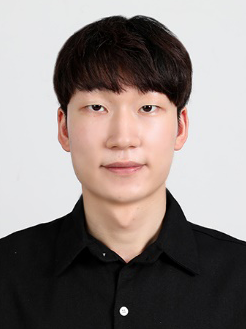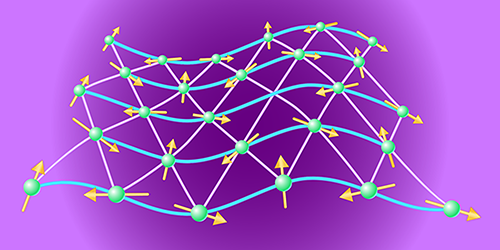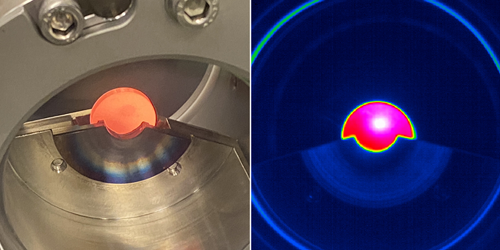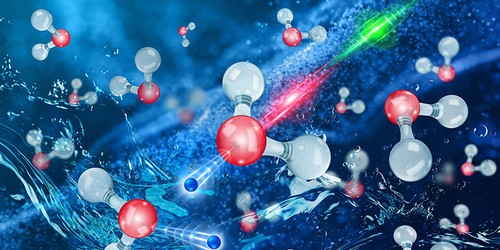• physics 17, 69
The researchers used thin layers of chiral nematic liquid crystals to observe the formation dynamics of skyrmions.
Skyrmions are a topologically stable, vortex-like field structure that cannot smoothly transform into a uniform state. [1].Physicist Tony Skyrme first proposed it as a nuclear model in 1961 [2]a concept that has since been studied in condensed matter physics and adjacent fields [3].In particular, skyrmions appear in magnetic studies [4]Bose-Einstein condensation [5]Quantum Hall System [6]liquid crystal [7], and other context (see, for example, Perspective: Water Can Hold Topological Waves and Synopsis: Skyrmions Made from Sound Waves). Skyrmions exhibit fascinating properties such as small size, stability, and controllability, which make them promising for applications in spintronics, data storage, and quantum computing. Despite extensive research on a variety of systems, instantaneous observation of skyrmion formation has been difficult to achieve due to the rapid dynamics of skyrmions and the narrow range of experimental conditions that produce them.Now, Jaka Pišljar at the Josef Stefan Institute in Slovenia and his collaborators have witnessed the formation of fractional skyrmions (specifically half skyrmions) in chiral liquid crystals [8].
Liquid crystals (LCs) have recently attracted the interest of researchers studying skyrmions because these systems have inherent advantages over other media, particularly in terms of experimental accessibility. For example, liquid crystals can be viewed directly under an optical microscope and manipulated through thermal phase changes. These properties mean that topological phenomena and the conditions that give rise to them can be easily generated and characterized. Among these conditions, a key one is chirality: in order to produce skyrmions, liquid crystals must be composed of molecules with obvious “handedness.” These molecules are stacked on top of each other, with slight twists between each molecule, forming a helical structure whose direction changes with height, like a spiral staircase. In this case, skyrmions are topological structures within helical arrays (regions where the symmetry of the surrounding order is broken due to local deviations in field direction) that occur during the transition from the isotropic phase of the liquid crystal to the helical structured phase formed during the process.A lot of research has been done on the generation and control of skyrmions in chiral liquid crystals [7]but how these complex three-dimensional structures form spontaneously remains unclear.
Pišljar and colleagues conducted a series of experiments in which a chiral liquid crystal film was sandwiched between two non-parallel glass surfaces so that the thickness of the liquid crystal film varied by 30 to several hundred nanometers. The glass surfaces are coated with polymethylmethacrylate to provide planar degenerate anchoring conditions, meaning surface interactions have minimal impact on the order in which the liquid crystal adopts. The researchers used two liquid crystal formulations with pitches of 360 and 710 nm (the pitch defines the length a helical structure must have in order for it to be oriented to complete a complete rotation).They used a diffraction-limited optical microscope with an optical resolution of 150 nm to observe the texture of the liquid crystal as it cools during the transition from an isotropic phase to a structured phase.
This transition is not simple. Between the isotropic phase and the final fully ordered structure, the cooling liquid crystal passes through a series of intermediate nematic states called the blue phase (named for its characteristic reflective properties). In one of these intermediate phases – the so-called blue phase I (BPI) – Pišljar and colleagues directly observed the formation of topological structures called half skyrmions.Full skyrmions represent a complete 360-degree radial rotation of the field direction from center to periphery, whereas in half-skyrmions the field is rotated 180 degrees [7].
The team observed these half-skyrmion clusters forming in thicker regions of the liquid crystal film ( 90 nm) just after it transitions through isotropic-BPI. Topological features originate from elongated domains, where local field directions differ from the surrounding environment. These regions then bend into a crescent shape and continue to bend until the two ends meet, at which point they resemble donut-shaped donuts with a diameter of about 100-300 nm (Fig. 1). When the film thickness is less than 70 nm, stable half skyrmions will not be formed. There, Pishrjar and colleagues observed bright, circular regions flickering as donut-shaped half skyrmions spontaneously changed into moon-like shapes and vice versa.
Using differential dynamic microscopy, which measures changes in a material based on the intensity of scattered light, the team determined the fluctuation rate of half skyrmions 101–102 hertz. These dynamics are much slower than those of the nematic sequence parameter (a measure of the LC sequence number), which fluctuates around 10.6 Hz is close to the isotropic-BPI transition. Pišljar and colleagues explained these differences in volatility by calculating the jump times between two symmetry-breaking free energy minima representing parallel (moon-shaped) or skyrmion (doughnut-shaped) shape) structure, consisting of small energy barriers. Finally, they show that this fluctuation not only breaks the continuous symmetry of the disordered phase, but also changes the topology of the orientation field since the moon-shaped and donut-shaped features have topological charges of 0 and 1 respectively. This is surprising because topological charge is a conserved quantity and therefore the orientation field is expected to always be topologically charge neutral. The researchers showed that when the liquid crystal cools down from this transition state, stable half-skyrmions form in large numbers and then merge together, restoring topological charge neutrality.
Pišljar and colleagues demonstrate that skyrmion fluctuations can be observed in very thin liquid crystal films, providing a new way to study the real-time dynamics of the formation of topological solitons, such as skyrmions, hopfions, and twists, that are Solitons are topologically non-trivial configurations in liquid crystals with knotted nematic fields. [9]. Their study will provide valuable insights into the fundamental properties of such topological entities and the topological phase transitions that occur in a variety of soft matter and magnetic systems, with applications extending to many fields, including magnetism, spintronics, and topology study.
refer to
- J. Wu and II Smalyukh, Hopfions, heliknotons, skyrmions, torons and Abelian and non-Abelian vortices in chiral liquid crystals, liquid. crystal. Priest. 1034 (2022).
- THR Skyrme, Unified field theory of mesons and baryons, nuclear. physics. 31556 (1962).
- B. Goebel et al.Beyond Skyrmions: A Review and Perspective on Alternative Magnetic Quasiparticles, physics. represent. 8951 (2021).
- S. Muhlbauer et al.skyrmion lattice in chiral magnets, science Chapter 323915 (2009).
- UA Khawaja and H. Stoof, Skyrmions in ferromagnetic Bose Einstein condensates, nature Chapter 411918 (2001).
- SL Sandy et al.the crossover from the integer sub-Hall effect to the fractional quantum Hall effect under skyrmions and small Zeeman energies, physics. Revision B 4716419 (1993).
- J. Fukuda and S. umer, Quasi-two-dimensional skyrmion lattice in chiral nematic liquid crystals, Nat. comminicate. 2246 (2011); D. Foster et al.Two-dimensional skyrmion pockets in liquid crystals and ferromagnets, Nat. physics. 15655 (2019); JB Tai and II Smalyukh, Surface anchoring as a control parameter for stabilizing torrons, skyrmions, twisted walls, fingers and their hybrid chiral nematics, physics. Revision E 101042702 (2020); G. Parker et al.fabrication of topological soliton arrays in patterned chiral liquid crystals for instant observation of morphogenesis, adverb. Matt. 34 (2022).
- J.Piljar et al.Dynamics and topology of skyrmion symmetry breaking, physics. Pastor Wright. 132178101 (2024).
- PJ Ackerman and II Smalyukh, the diversity of junction solitons in liquid crystals is reflected by the connection of original images in toron and hopfion, physics. Revision X 7011006 (2017).
About the author
academic area
#Witness #birth #Skyrmion
Image Source : physics.aps.org






